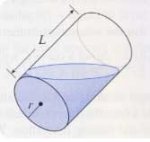"A cylindrical glass of radius r and height L is filled with water and then tilted until the water remaining in the glass exactly covers its base.
You are using an out of date browser. It may not display this or other websites correctly.
You should upgrade or use an alternative browser.
You should upgrade or use an alternative browser.
Cylinder Tilted Volume
- Thread starter maxhk
- Start date
"A cylindrical glass of radius r and height L is filled with water and then tilted until the water remaining in the glass exactly covers its base.
Determine a way to "slice" the water into parallel cross-sections that are trapezoids and then set up a definite integral for the volume of the water."
Can you please provide a solution to this problem and ? and if possible a diagram of your cross sections and computations ? Thanks
View attachment 1389
Any ideas ?
The trapezoidal cross-sections are obtained by taking a plane that is both vertical and parallel to the longitudinal axis (i.e., parallel to the side of the glass) and passing it through the glass from one side to the other. The height of the trapezoid starts at 0 when this plane is at the side (just touching) the glass, and it is a maximum (and equal to 2r) when the plane intersects the centerline (longitudinal axis) of the glass. When on the centerline, the top "base" of the trapezoid is 0, and the bottom base is L. In other words, the trapezoid has become a triangle at that position. Hope that helps.
Per wjm's suggestion, I have been looking at this.
The diagram has no axes pictured, so I am going to place the y axis vertical.
From the top where the water just touches the base.
Now, as wjm stated, make the slices parallel to this y axis.
The area of a trapezoid is \(\displaystyle \frac{1}{2}h(a+b)\). Where a and b are the top and bottom base lengths.
This leaves dx to be the thickness of each slice.
So, the volume of each slice will be the area of the trapezoid times the thickness.
What may be initially difficult to envision is that the sum of the lengths of the trapezoids bases is equal to
L. And, if we place a longitudinal axis through the cylinder (maybe call it z), then the height of the
trapezoid is a distance y on either side of it. Giving the height of the trapezoid equal to 2y.
This means the area is \(\displaystyle \frac{1}{2}2y\cdot L=yL\)
So, the volume of each trapezoid would be \(\displaystyle yLdx\)
You are correct about \(\displaystyle y^{2}=r^{2}-x^{2}\).
So, we end up with \(\displaystyle \int_{-r}^{r}\frac{1}{2}L\cdot 2\sqrt{r^{2}-x^{2}}dx\)
\(\displaystyle =\frac{{\pi}r^{2}L}{2}\).
Which is the result we would expect to arrive at because half of the cylinder is full.
I will try to make a diagram of what I am trying to explain. See the trapezoid in the center?.
The diagram has no axes pictured, so I am going to place the y axis vertical.
From the top where the water just touches the base.
Now, as wjm stated, make the slices parallel to this y axis.
The area of a trapezoid is \(\displaystyle \frac{1}{2}h(a+b)\). Where a and b are the top and bottom base lengths.
This leaves dx to be the thickness of each slice.
So, the volume of each slice will be the area of the trapezoid times the thickness.
What may be initially difficult to envision is that the sum of the lengths of the trapezoids bases is equal to
L. And, if we place a longitudinal axis through the cylinder (maybe call it z), then the height of the
trapezoid is a distance y on either side of it. Giving the height of the trapezoid equal to 2y.
This means the area is \(\displaystyle \frac{1}{2}2y\cdot L=yL\)
So, the volume of each trapezoid would be \(\displaystyle yLdx\)
You are correct about \(\displaystyle y^{2}=r^{2}-x^{2}\).
So, we end up with \(\displaystyle \int_{-r}^{r}\frac{1}{2}L\cdot 2\sqrt{r^{2}-x^{2}}dx\)
\(\displaystyle =\frac{{\pi}r^{2}L}{2}\).
Which is the result we would expect to arrive at because half of the cylinder is full.
I will try to make a diagram of what I am trying to explain. See the trapezoid in the center?.
Attachments
Last edited:
Per wjm's suggestion, I have been looking at this.
The diagram has no axes pictured, so I am going to place the y axis vertical.
From the top where the water just touches the base.
Now, as wjm stated, make the slices parallel to this y axis.
The area of a trapezoid is \(\displaystyle \frac{1}{2}h(a+b)\). Where a and b are the top and bottom base lengths.
This leaves dx to be the thickness of each slice.
So, the volume of each slice will be the area of the trapezoid times the thickness.
What may be initially difficult to envision is that the sum of the lengths of the trapezoids bases is equal to
L. And, if we place a longitudinal axis through the cylinder (maybe call it z), then the height of the
trapezoid is a distance y on either side of it. Giving the height of the trapezoid equal to 2y.
This means the area is \(\displaystyle \frac{1}{2}2y\cdot L=yL\)
So, the volume of each trapezoid would be \(\displaystyle yLdx\)
You are correct about \(\displaystyle y^{2}=r^{2}-x^{2}\).
So, we end up with \(\displaystyle \int_{-r}^{r}\frac{1}{2}L\cdot 2\sqrt{r^{2}-x^{2}}dx\)
\(\displaystyle =\frac{{\pi}r^{2}L}{2}\).
Which is the result we would expect to arrive at because half of the cylinder is full.
I will try to make a diagram of what I am trying to explain. See the trapezoid in the center?.
Thanks a lot "galactus" for your working out the solution and drawing a diagram and thanks "wjm" for your suggestion that was helpful!


